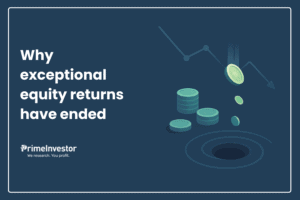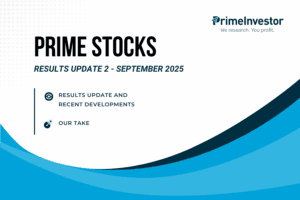Any long-term portfolio needs a component that can add a kicker to overall returns and make up for the unexciting returns that the large-cap portion delivers. To get this kicker though, you need not bottom-fish mid-cap or small-cap stocks in the market. There’s another index that gives mid and small-cap funds a good run for their money while housing far bigger names. This is a high return index if highly volatile one, and can be used in long-term portfolios to give returns a boost.

About the index
The high return index we’re referring to is the Nifty Next 50 (Next 50). The index houses the 50 biggest stocks in the market, by capitalization, after the Nifty 50. But it dons the role of a mid-cap component in your portfolio because of its return profile. We did some number-crunching to assess its behaviour.
- Scores well on the upside: Consider the 1-year periods when the Nifty 50 rallied. In these times, the Next 50 delivered 30% more on an average. Over the longer 5-year period too, the Next 50’s upside capture ratio was a good 124%. The Next 50’s average returns in longer-term 3 and 5-year periods are on par with the Nifty Midcap 150.
- Falls sharply during corrections: In the past 15 years, the lowest the 1-year return the Next 50 generated was a 66% loss. The Nifty 50, on the other hand, clocked a 55.7% loss. Stretching it out to 3 years, the worst Next 50 return was a 16% loss against the 6% on the Nifty 50. The Next 50 slipped into losses 27% of the time considering 1-year returns, over the past 15 years. In contrast, the Nifty 50 was loss-making 22% of the time. On the basis of downside capture ratio, the Next 50 fares poorly against both the Nifty 50 and the Nifty 100.
- High on volatility: The Next 50’s volatility across timeframes is much higher than the Nifty 50 as well as the Nifty 100. While it is not as volatile as the mid-cap index, the Next 50 tends to fall more frequently and steeply, especially in shorter periods.
What this translates into is that the Next 50 is a high-risk, high return index that delivers when markets are rallying, but falters in corrective phases. This tendency is because the Next 50 plays the middle ground. In corrective phases, stocks that slip out of the top 50 find their place in the Next 50. They therefore weigh on the Next 50’s returns as well. But the Next 50 also captures the stocks which are likely to graduate to bluechip status, which adds to their gains during rallies.
Over the longer 5-year period, the Next 50’s upside capture ratio was a good 124% against the Nifty 50
Since the Next 50 manages strong performance on upswings, the index still beats the Nifty 100 and the Nifty 50 with a reasonable degree of consistency in the long term. Rolling 5 year returns in the past 15-year period show the Next 50 beating the Nifty 100, 87% of the time.
Average 5-year returns for the Next 50 stood at 13.3% against the 10.4% of the Nifty 50, a sizeable outperformance. The Nifty 100, though drawing from stocks in the Nifty 50 and the Next 50, owes the majority of its weight to the Nifty 50 components. As a result, the Nifty 100 is very similar to the Nifty 50 in performance trends.
One of the drawbacks of investing in market indices like the Nifty50 is the high stock and sector concentration. But the Next 50 has a more diversified sector distribution than either the Nifty 50 or the Nifty 100. The top 5 sectors for the Nifty 50 account for 82% of its weight. The same stands at 63.5% for the Next 50. While this helps reduce concentration risk and allows the Next 50 to tap into a wider range of opportunities. Of course, this is a handicap when select sectors rally hard.
Opportunities in recent performance
It is this sectoral impact that has played out against the index in the past year. 1-year returns for the Next 50, at 56% are below the Nifty 100 and the Nifty 50’s 58%. Just a couple of weeks ago, the return differential was much wider at 10 percentage points.
Primarily, this has to do with the sedate performance from defensive sectors such as consumer goods in the past year while cyclicals have been the market darlings. Consumer goods make up a good 17% weight in the Next 50. Stocks such as Dabur India, Colgate Palmolive, United Spirits and Avenue Supermart, for example, have delivered flat to low returns.
Two, the Next 50 has a lower weight to financial services than Nifty 50 and negligible weight to software. Both sectors, which dominate the Nifty 50 and the Nifty 100, saw strong performance – stocks such as Infosys, TCS, Wipro, SBI, Bajaj Finance and others have shot up, doubling or being close to it in the past 1 year. The multi-fold rally in metal stocks such as JSW Steel and Tata Steel also helped the Nifty 50, while the Next 50 had relatively more sedate metal plays in Vedanta and NMDC.
But this tide appears to be turning now. With financial stocks correcting, the recent performance of the Next 50 has been picking up compared to the Nifty 50. Further, a higher weight to pharma stocks in the Next 50 has helped. 1-month and 3-month returns for the Next 50 have recently moved above the Nifty 50 and the Nifty 100.
Next 50 vs other indices
Given the nature of the Next 50, the Nifty 50 and the Nifty 100 may not be adequate comparisons. The other high-return indices – which are available to invest in – are the Nifty Alpha Low Vol 30 and the Nifty Midcap 150.
- Against the Midcap 150, the Next 50 holds up well. It is much lower in volatility especially in longer term periods. In terms of consistency, the Next 50 beats the Midcap 150 about half the time.
- Against the Alpha Low Vol 30, the Next 50 does not fare well – to be fair, the Alpha Low Vol 30 is a strong performer against most indices since it combines high returns with downside containment (read our analysis of the index here). However, there are few options to play the index and there is no track record in terms of tracking error. Moreover, the index itself is new and real-time management of the index and funds’ ability to track it needs to be seen.
For those with a lower-risk appetite, the Next 50 works well to introduce the high-return component that mid-caps possess but with lower volatility.
Using the Nifty Next 50
Given its volatility and tendency to underperform in short-term periods, the Next 50 is best suited for timeframes of at least 5 years or more where you can ride out a complete cycle. The index gets more consistent and delivers well only over such periods. The Nifty Next 50 index can be used by any investor across risk appetites.
- High risk investors can use the index to partly substitute a large-cap fund, or can use as part of a multi-cap exposure, instead of upping mid-cap/small-cap exposure to increase portfolio returns.
- For those with a lower-risk appetite, the Next 50 works well to introduce the high-return component that mid-caps possess but with lower volatility. For very conservative investors, it can even fully substitute midcap funds.
- Investors looking for a ‘growth’ style index to diversify their portfolios can opt for it.
Which funds to use
In Prime Funds, we have two recommendations to hold the Nifty Next 50 index. These are ICICI Pru Nifty Next 50 and UTI Next 50. Both funds are very similar in tracking error of slightly longer periods of 1 year. In shorter periods, the UTI fund is marginally better. While there are several other funds tracking the Next 50, these are relatively newer and lack a record to judge tracking error, or are far smaller in AUMs.
The expense ratio (direct plan only) for UTI Next 50 is lower at 0.34 currently against the 0.39 for ICICI Pru Next 50. However, note that the differential between the two has been much wider in earlier months – UTI Next 50’s expense ratio used to be less than 0.30; the fund has gradually increased the expense ratio over the past two years. Therefore, do not take the current expense ratio levels as enduring. Go with either fund.




20 thoughts on “Prime Recommendation: Mid-cap returns with would-be bluechips”
Do you think small cap index funds recently launched by Motilal and Nippon are a good option or they more likely to underperform than the active small cap funds in long run? Alpha generation is more likely in small caps?
Yes, many active smallcaps have managed to thus far comfortably beat indices. thanks, Vidya
Bhavana, Thanks a lot for such a detailed and wonderful article. Class apart!
A real eye opener for investors looking for passive funds in large cap space but looking for higher returns similar to midcap category. Once again, thank you so much for the detailed article.
Thanks! – Regards, Bhavana
Very good comparison with relevant supporting data points that helps to baseline the investment decision regarding potential consideration for inclusion in existing portfolio. Thank you !!
I find there are two funds each: ICICI PRU NIFTY 50 ETF and ICICI PRU NIFTY NEXT 50 INDEX . Similarly in UTI. Which funds are you recommending?
The Nifty 50 ETF is on the Nifty 50 index. In this report, we’re recommending the Nifty Next 50 index. You can go with either fund that has been mentioned in this report. If you’re looking for ETF on the Next 50 instead of a fund, please refer to Prime ETF for our recommendation. – thanks, Bhavana
Good article. But, the rolling returns of midcap fund, e.g., Axis midcap vs Icici next 50 gives different picture. Even valuersearch shows mean of 6.5 for Icici next 50 against std deviation of 21 over 3 yr period. So, not really a clear option ot seems
You’re correct – Axis Midcap outperforms the Next 50. But few points here…one, the Next 50 is not a mid-cap substitute. It can give similar returns, and as we said the Next 50 beats the Midcap 150 about half the time. Which means that mid-caps will be able to deliver more when there are good mid-cap rallies. Recent returns are a good example here. Two, Axis Midcap is a quality fund that beats the the Midcap 150 – so its propensity to outperform is also higher. There are other mid-cap funds which don’t match up well against the Next 50.
The choice is not between Next 50 and midcaps. The Next 50 is a good way to add return potential to a portfolio without the full mid-cap risk. There’s space for both in a portfolio…so for example, for aggressive investors, instead of increasing mid-cap allocation can instead use this index.
Thanks,
Bhavana
Thanks for the detailed reply Bhavana, much appreciated.
Does expense ratio by say 50 bps matters in equity funds ?
Expense ratio matters, yes. In equity, because returns can be very high, it matters less than in debt. But a move of 0.5 is not small, in any fund. – thanks, Bhavana
Good article. Is Juniorbees (ETF) a better option than index funds (ICICI & UTI)?
You can go with either. Juniorbees has good volumes and low tracking error, so it is fine to invest in. Please read this article on index funds vs ETFs: https://www.primeinvestor.in/should-you-go-for-index-funds-or-etfs/ – thanks, Bhavana
Thanks Bhavana for clear explanation on how to use NN50. Regarding TER changes rapidy by AMC, as an cost conscious Index investor, how do i treat TER changes. Should we change if any big rise in the TER, For instance UTI N50 was hiked 0.18% from 0.10%. Should we keep some permissable CAP for this TER raise. for instance, we will keep the same fund till the TER touches 0.50 -0.80 %.
If the tracking error is low, it is fine to continue with the fund even if it increases TER. It is very unlikely that TERs go anywhere near those of active funds. – Bhavana
Hi,
I have started investing in Nippon India ETF Junior BeES recently for long term. Please let us know if this ETF is better than the Index funds mentioned in the article or should I switch to Index funds.
How the Nippon India ETF Junior BeES does when compared to the index funds.
thanks,
Balaji
It’s fine to continue with Juniorbees. It’s been around a long time and has good volumes and low tracking error. You don’t need to switch back into index funds, simply go with whichever is more convenient to you. You can read our article on index funds vs ETFs for a more detailed understanding – https://www.primeinvestor.in/should-you-go-for-index-funds-or-etfs/ – thanks, Bhavana
Another amazing article !
Thanks! – Bhavana
Comments are closed.